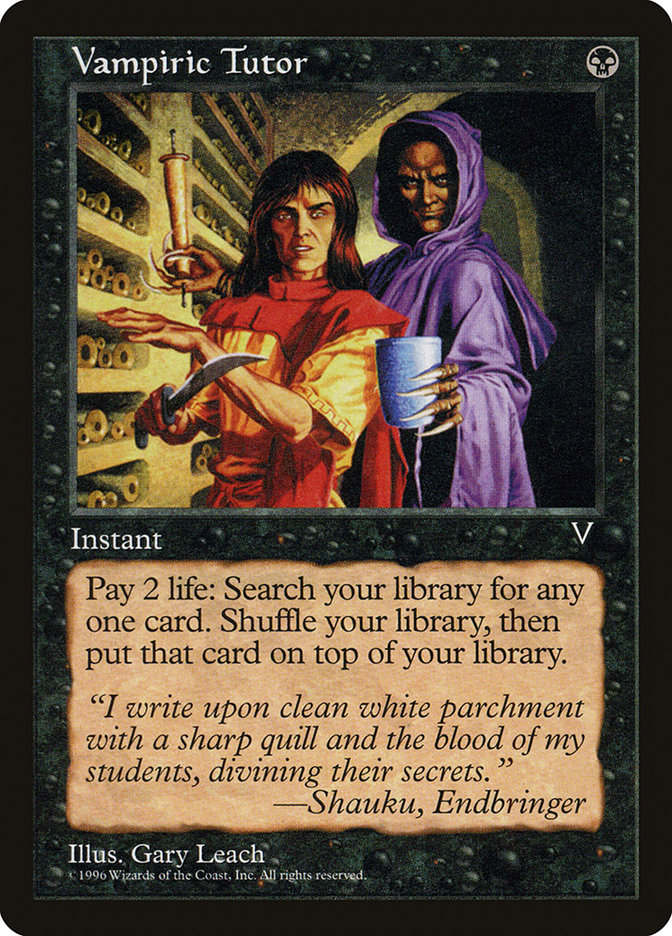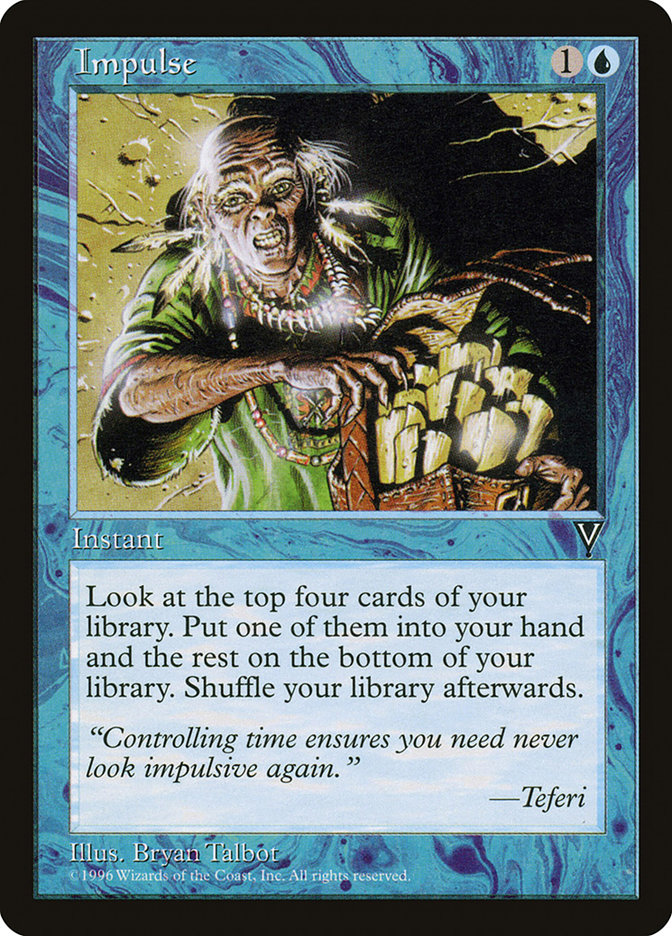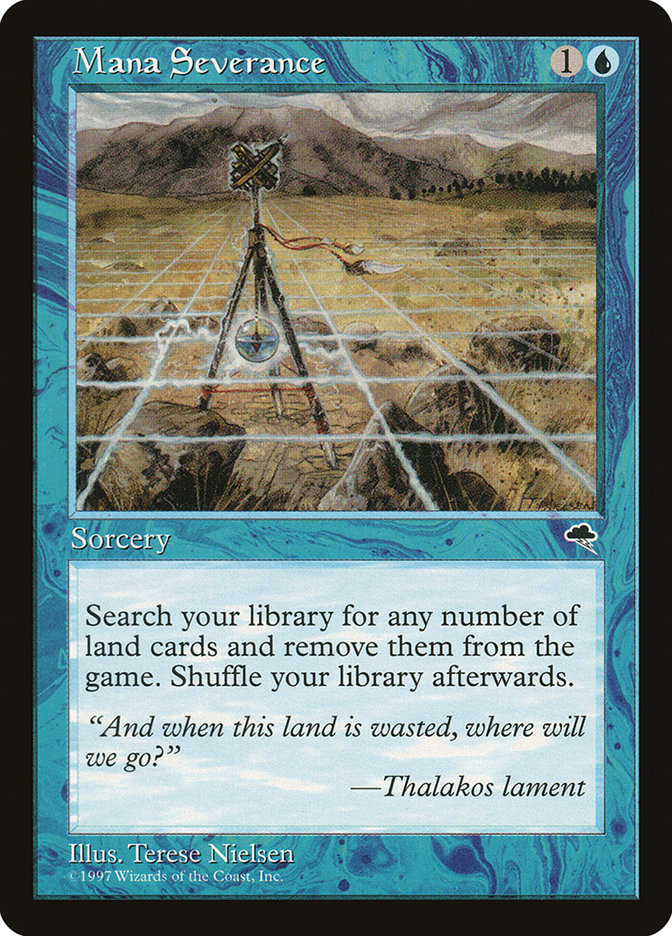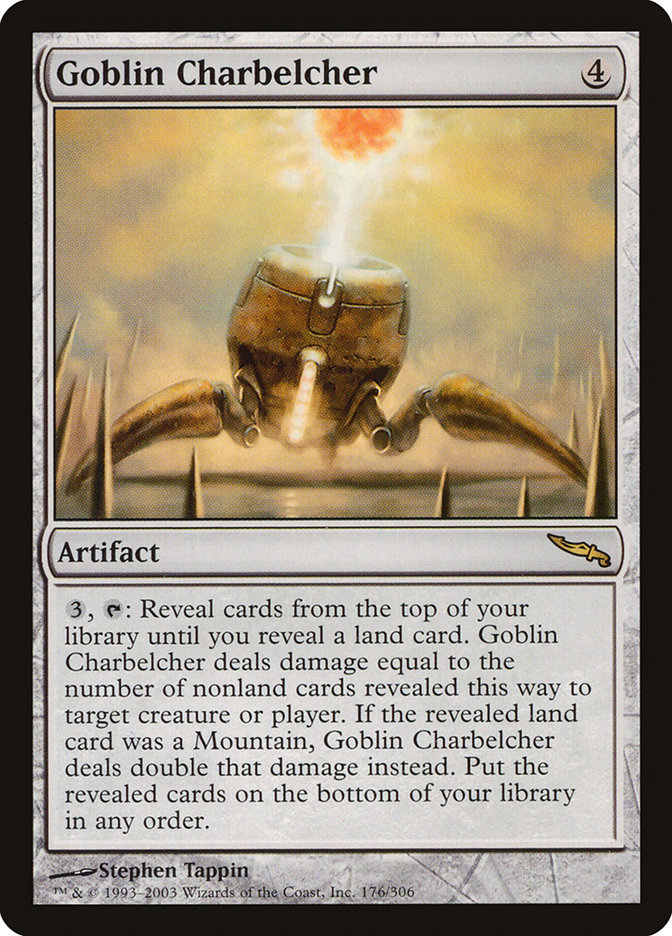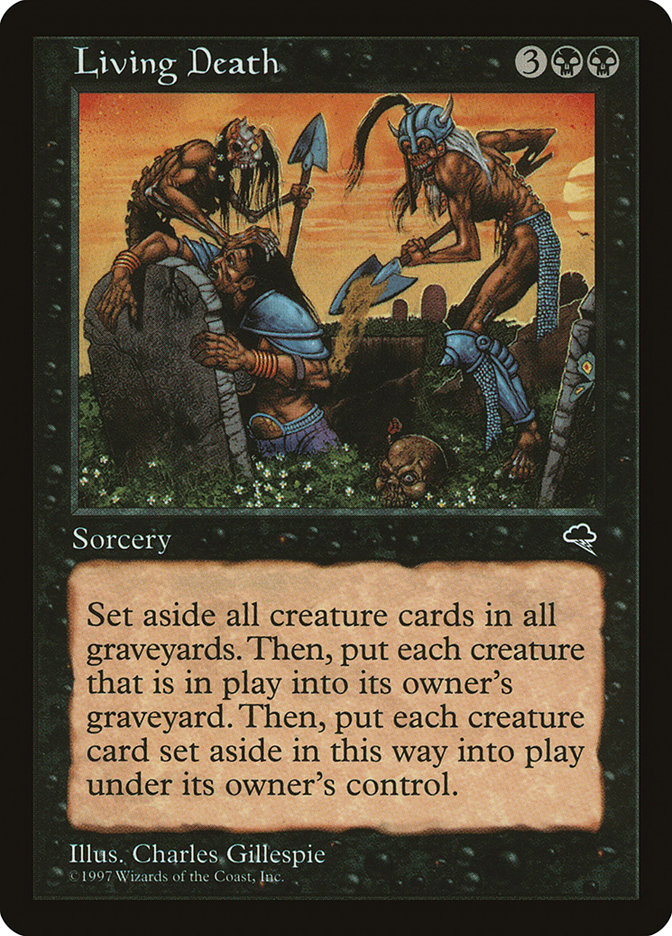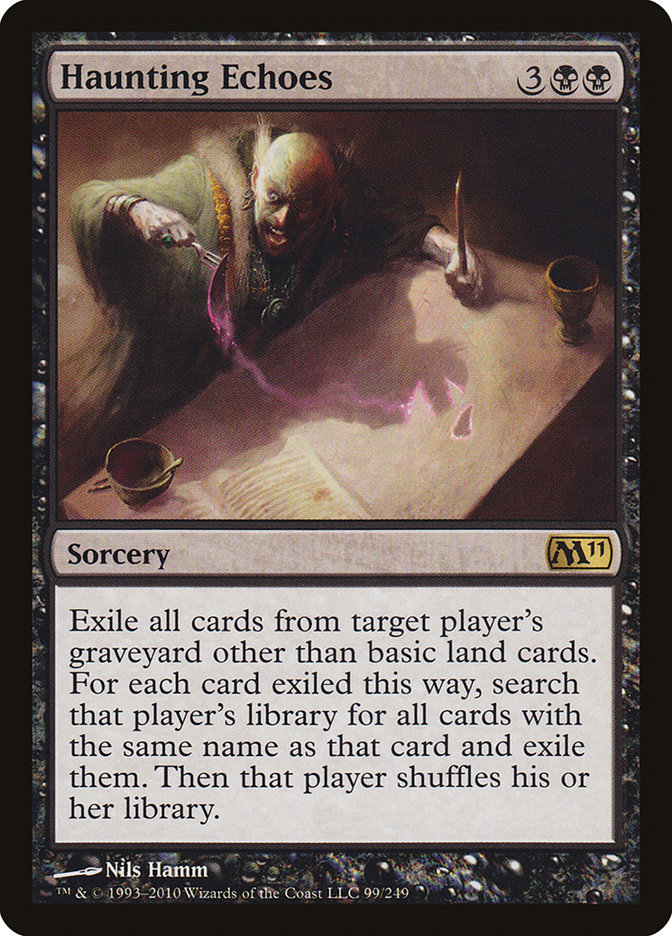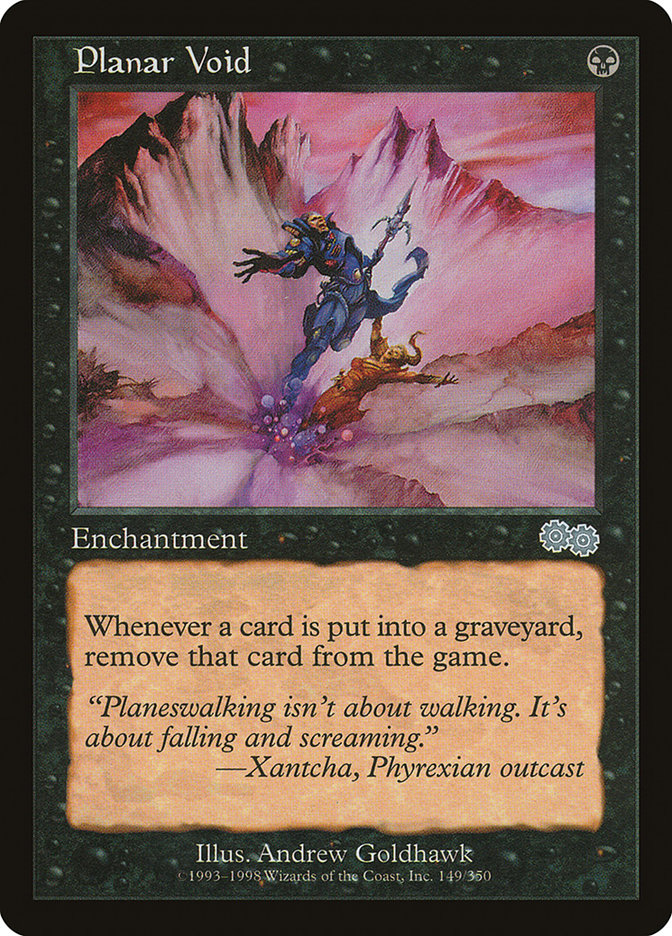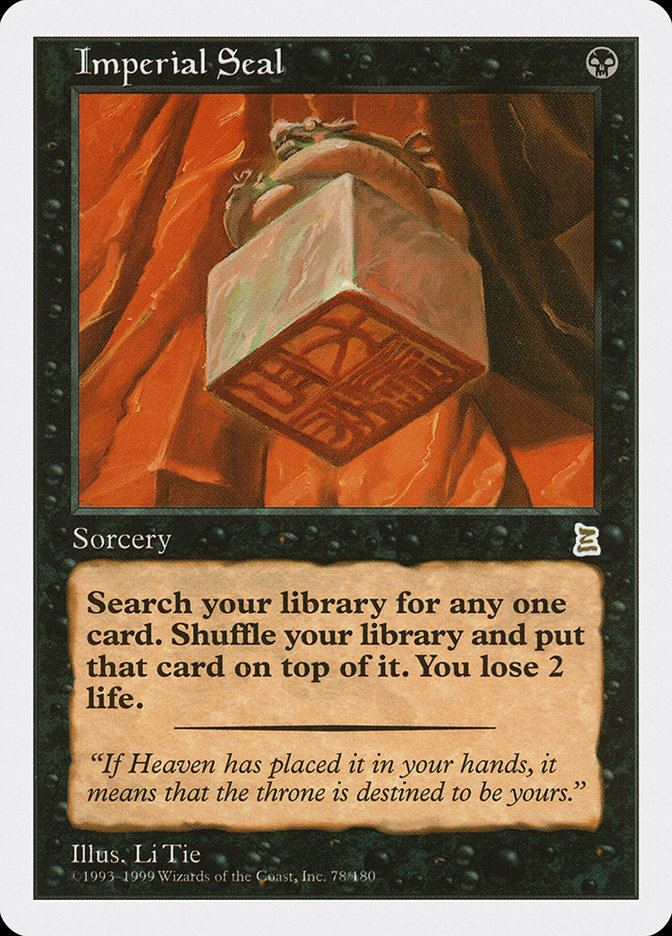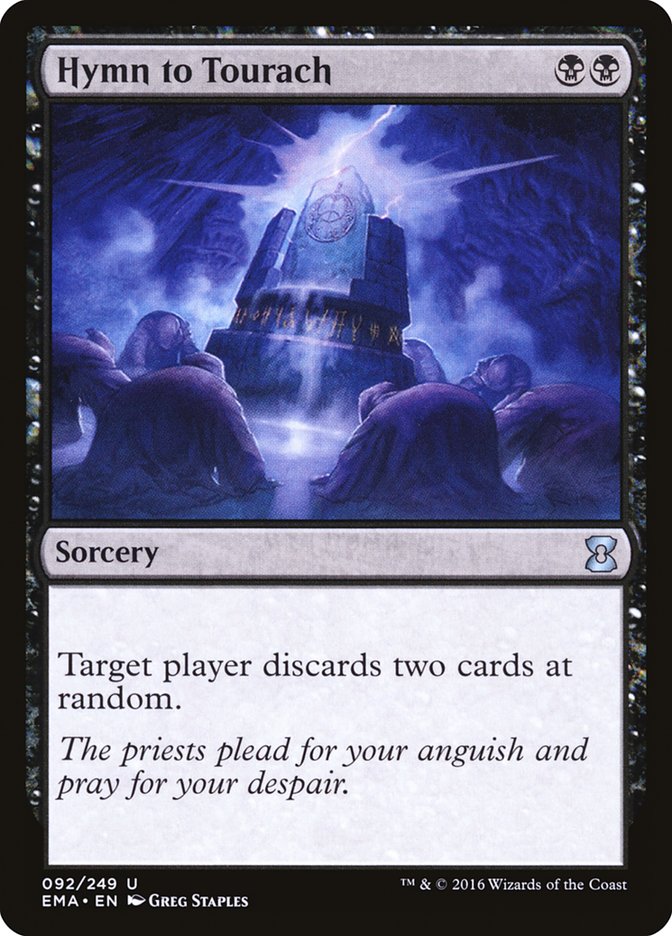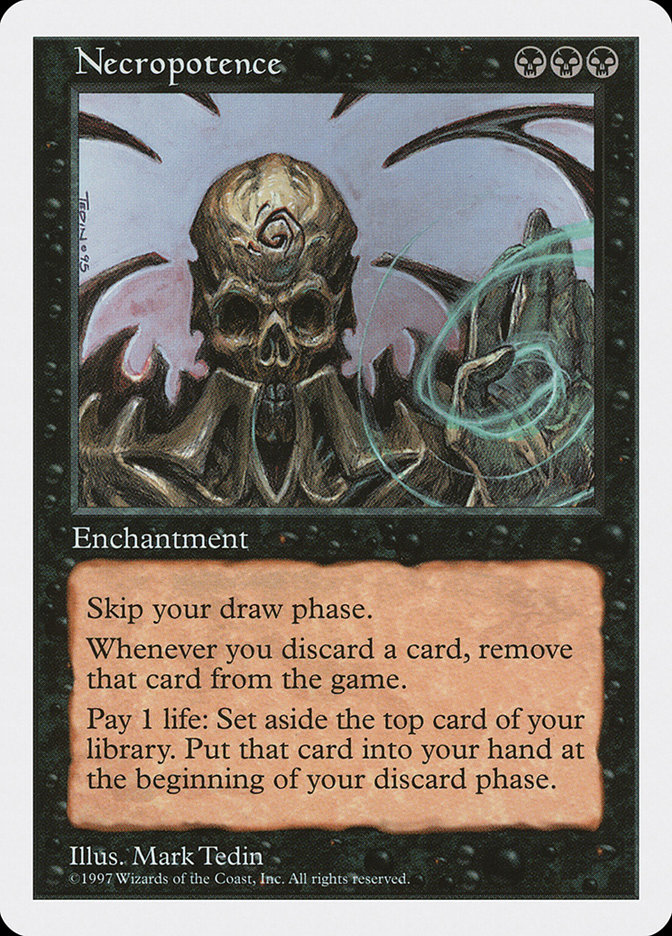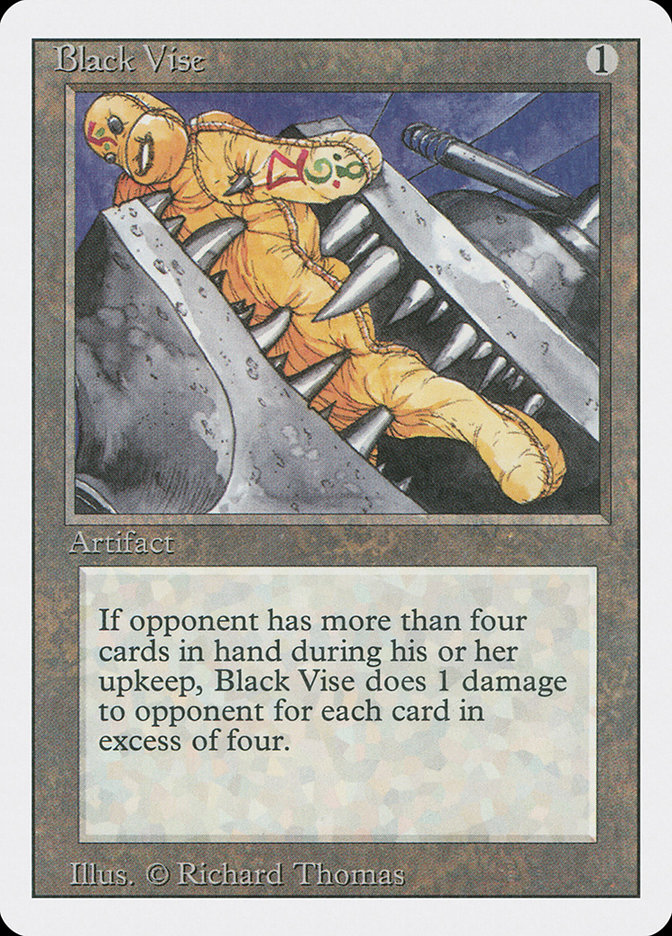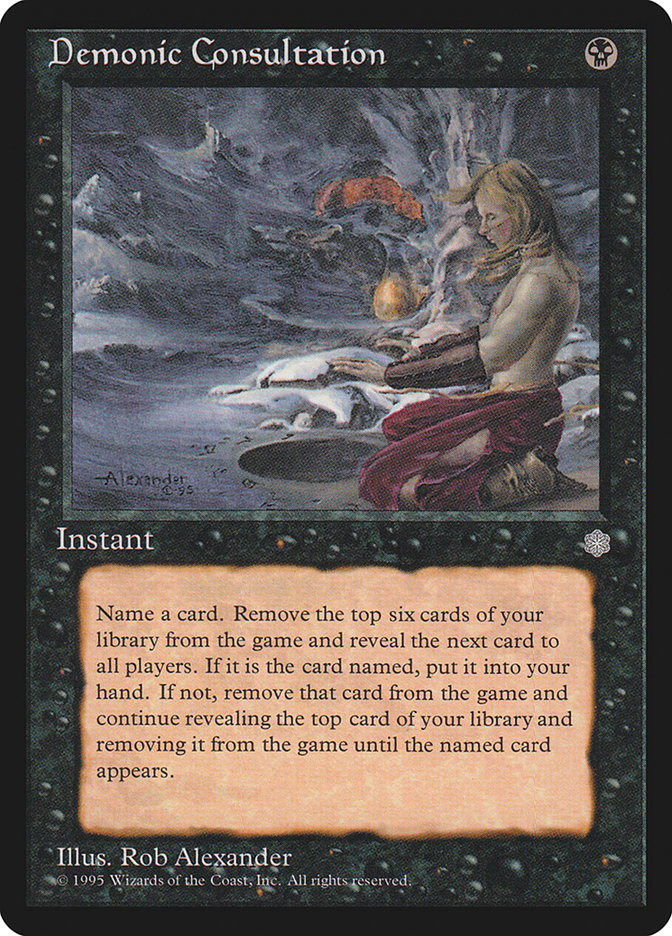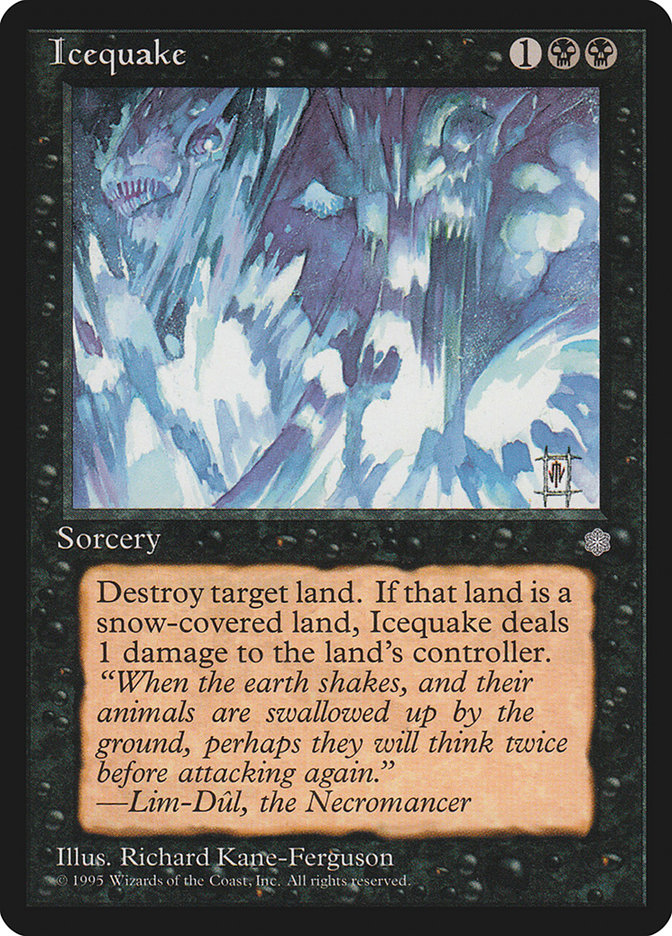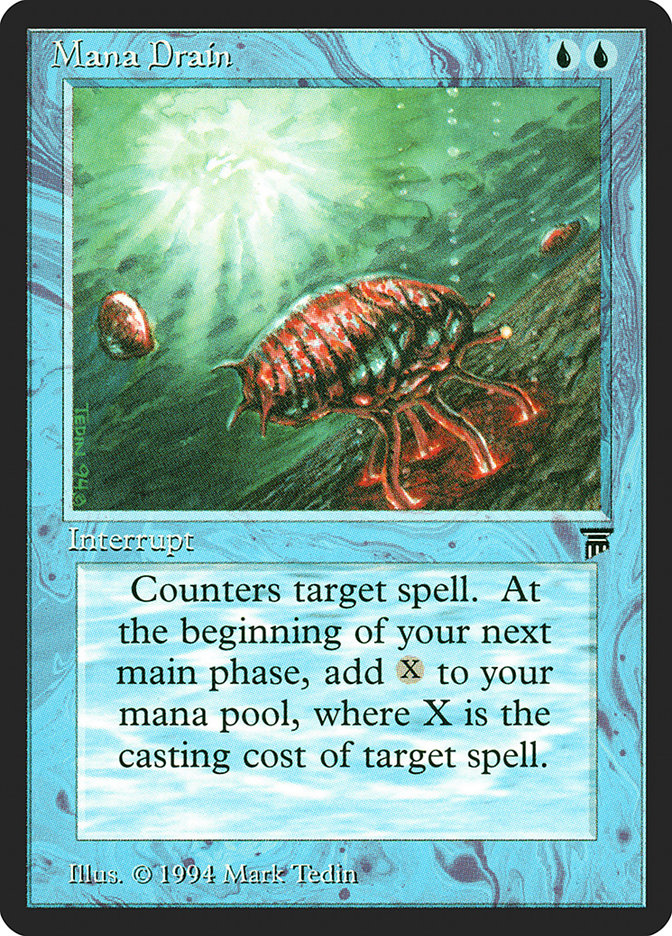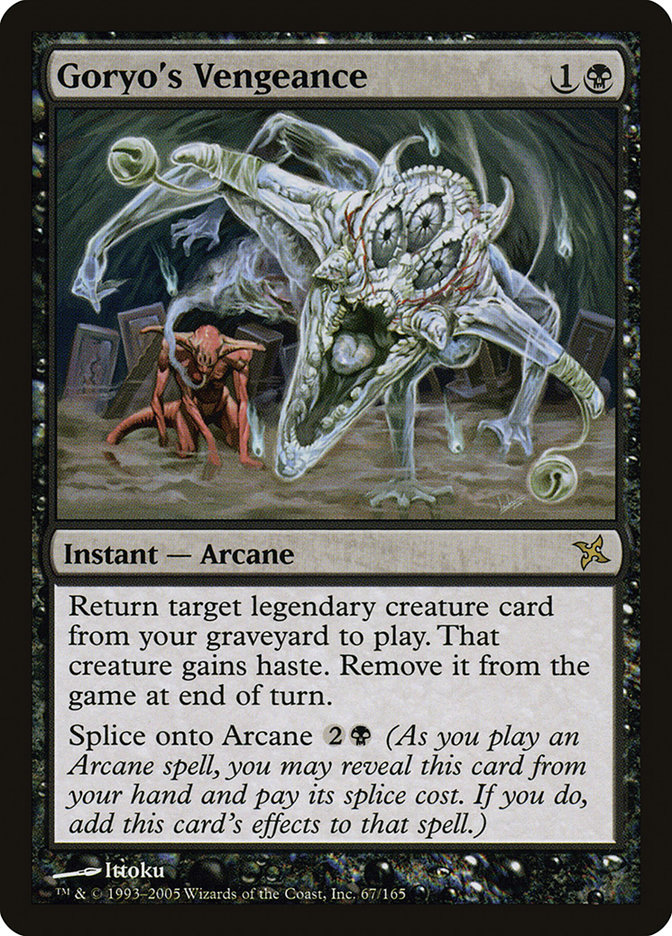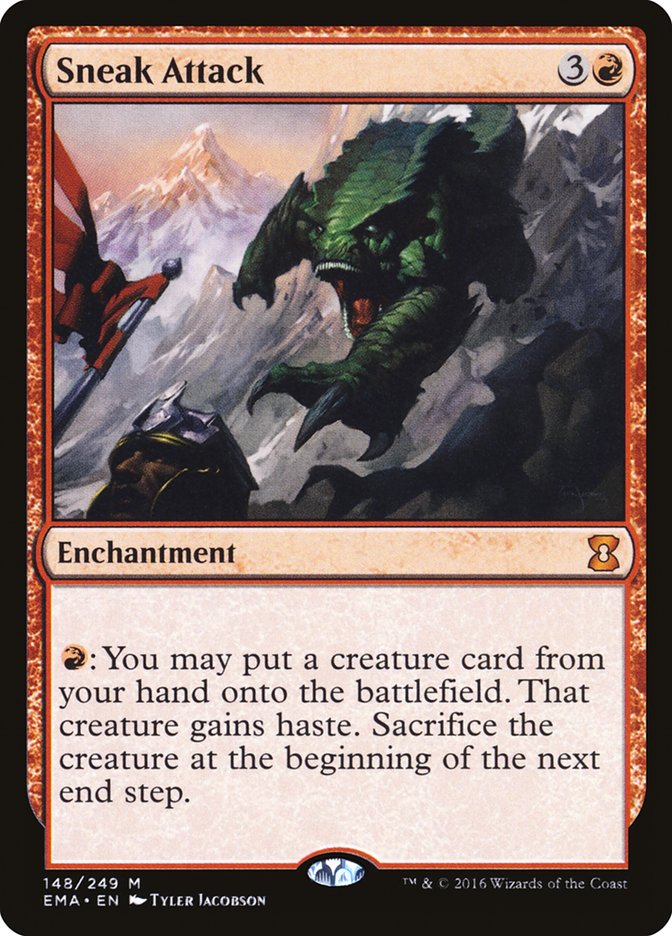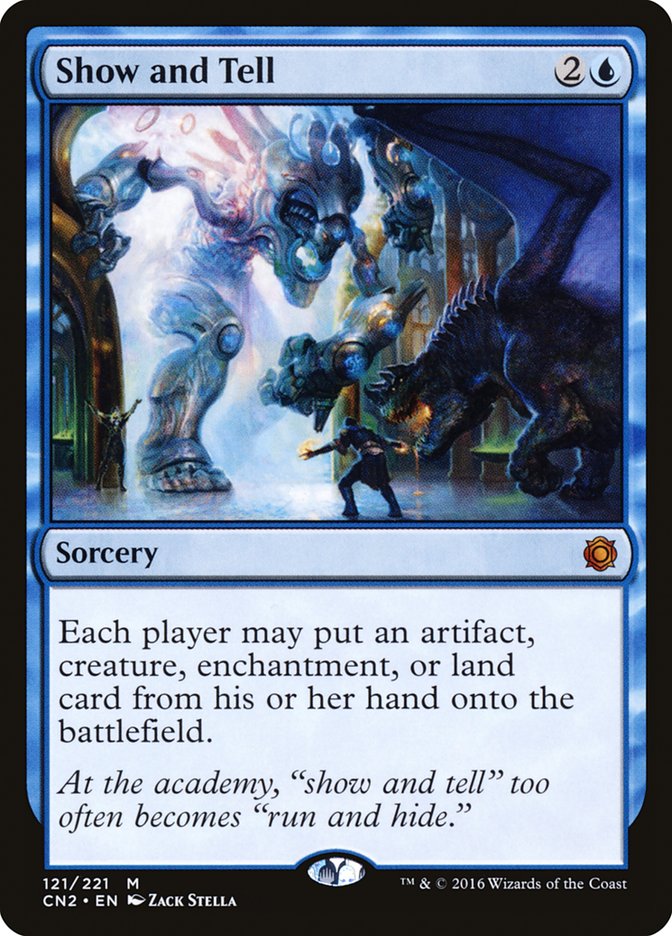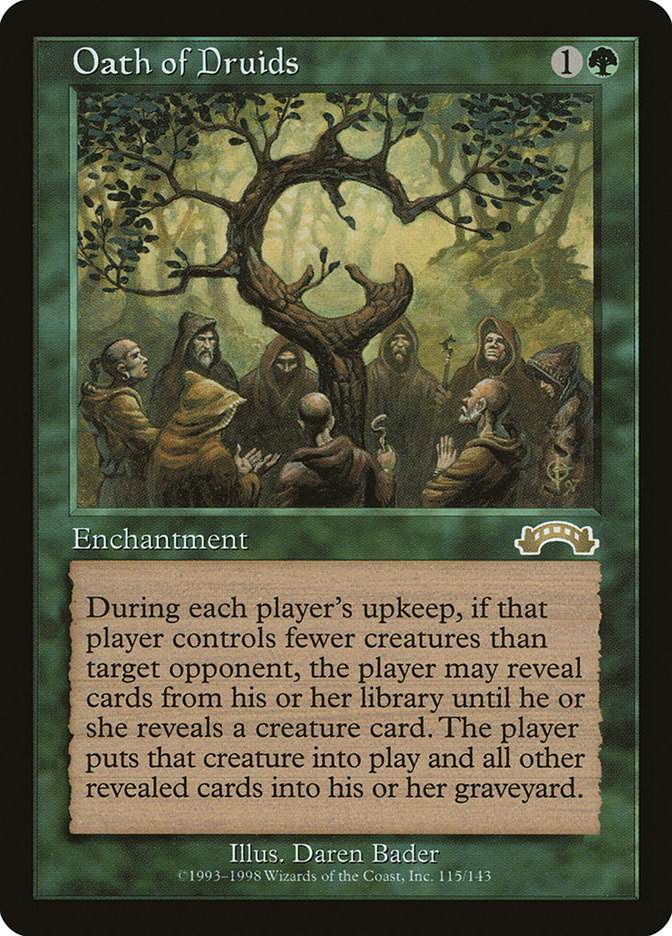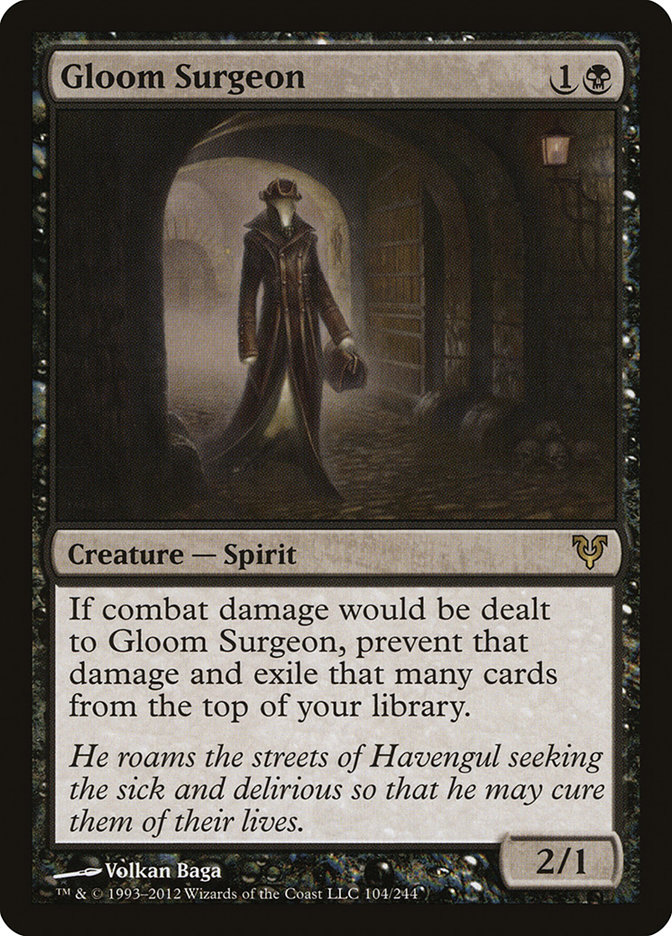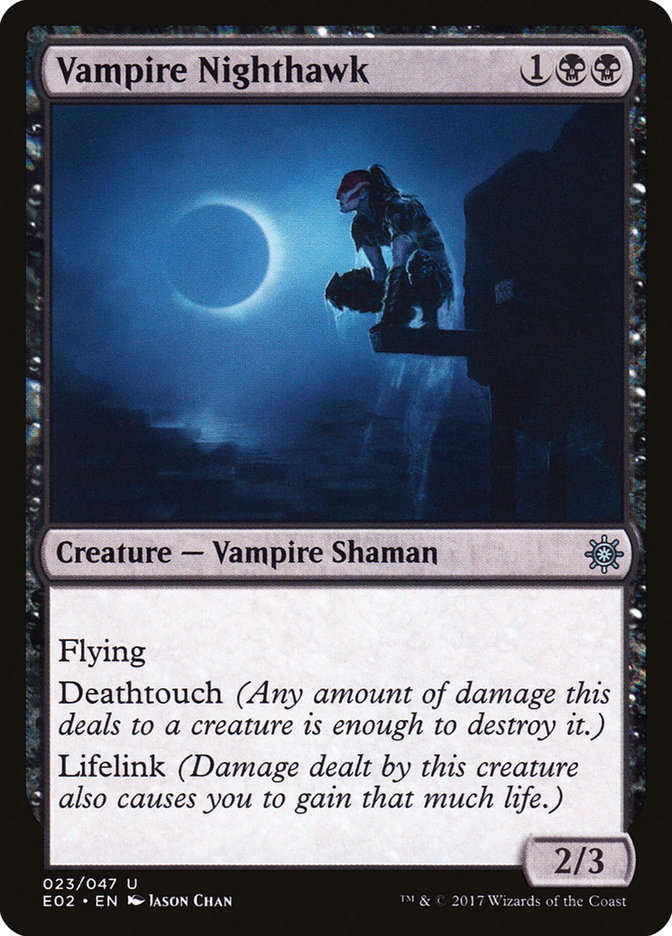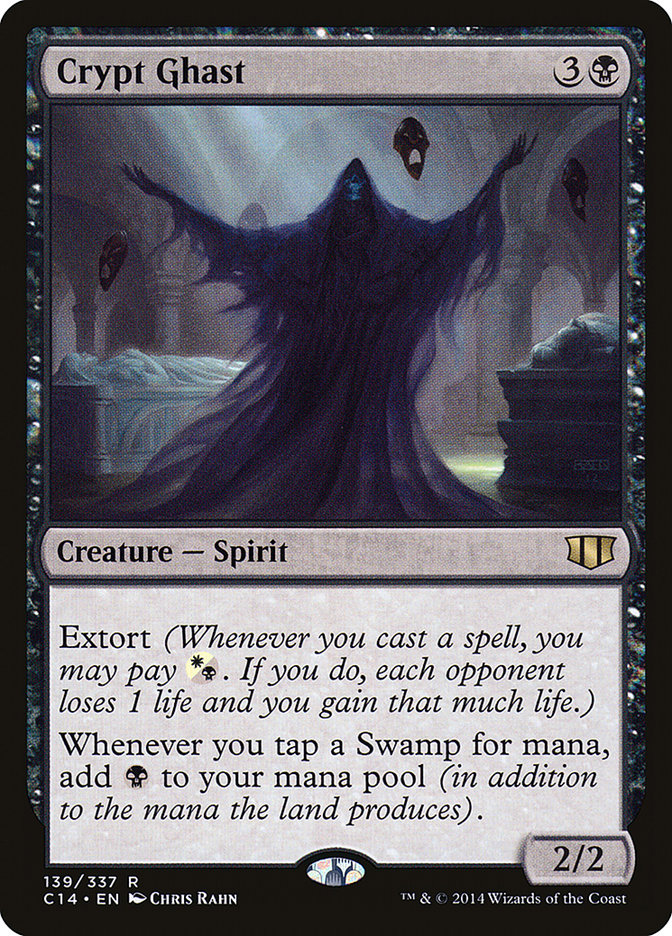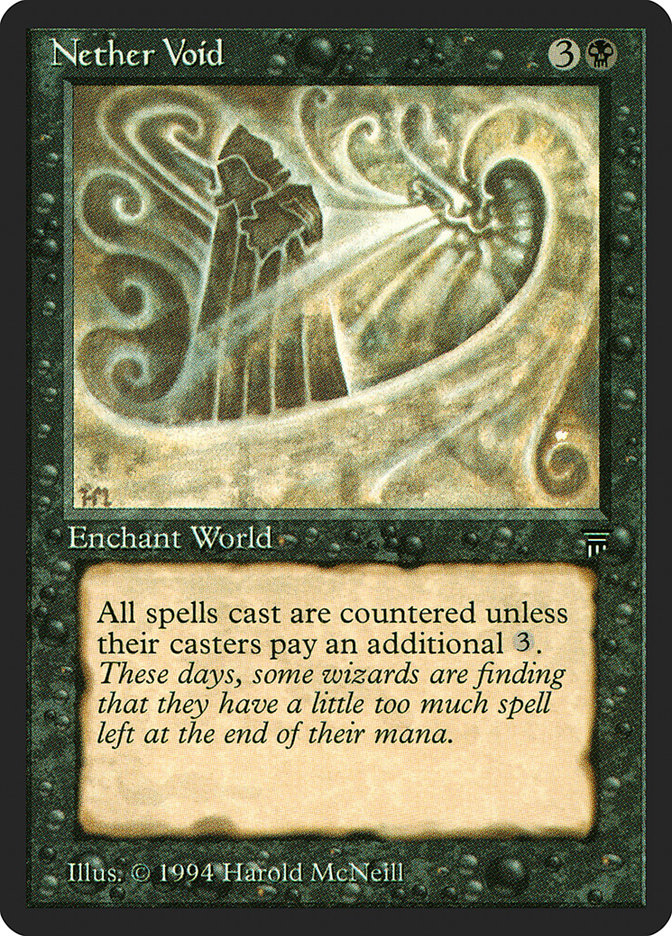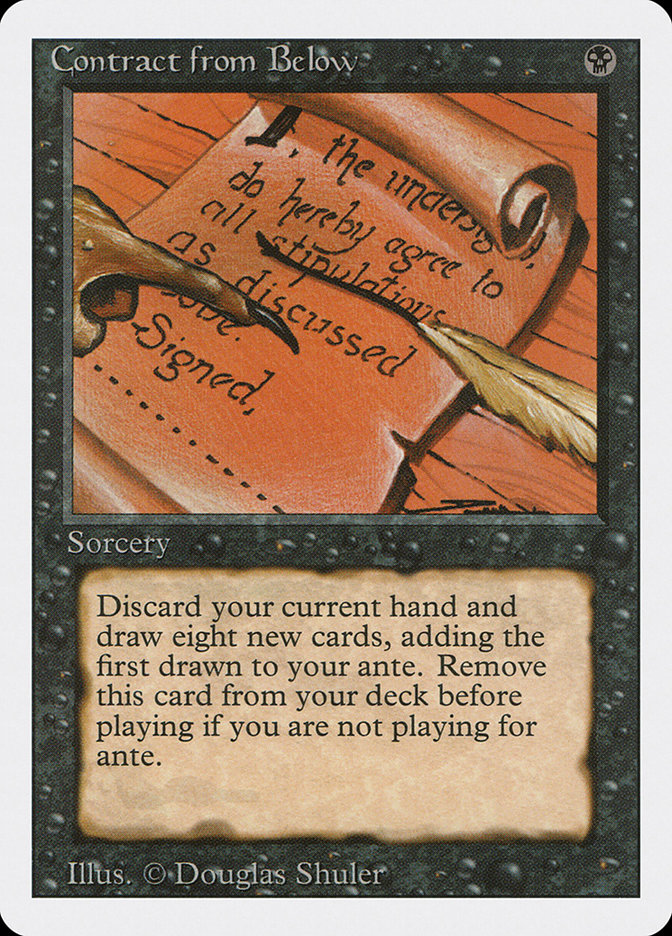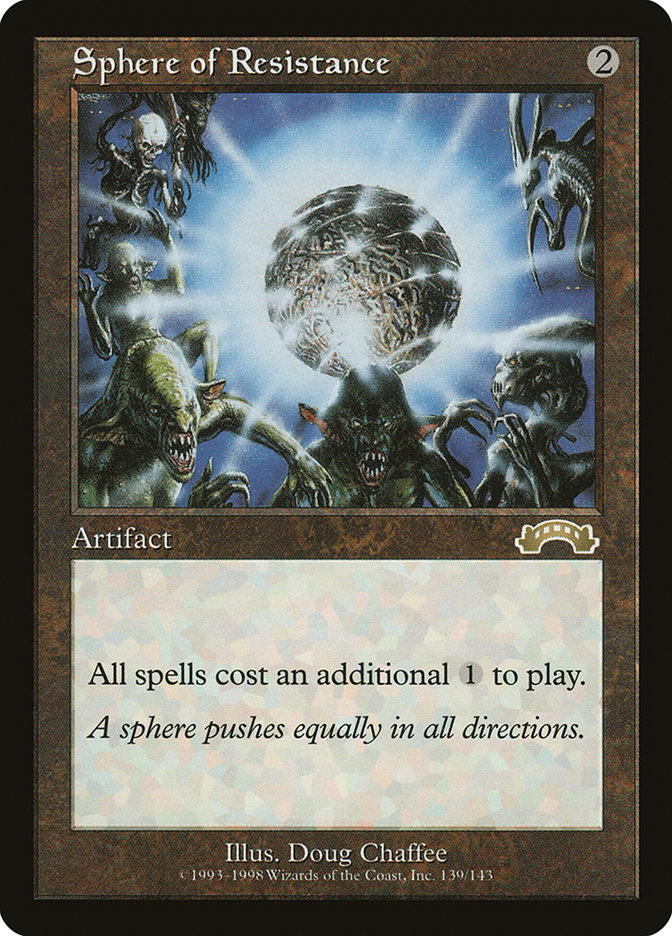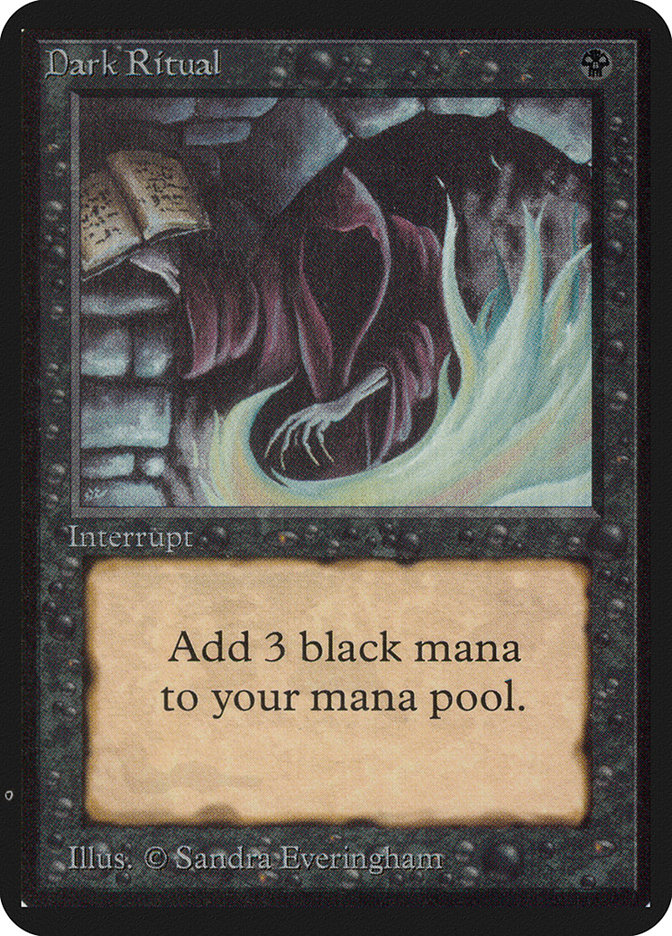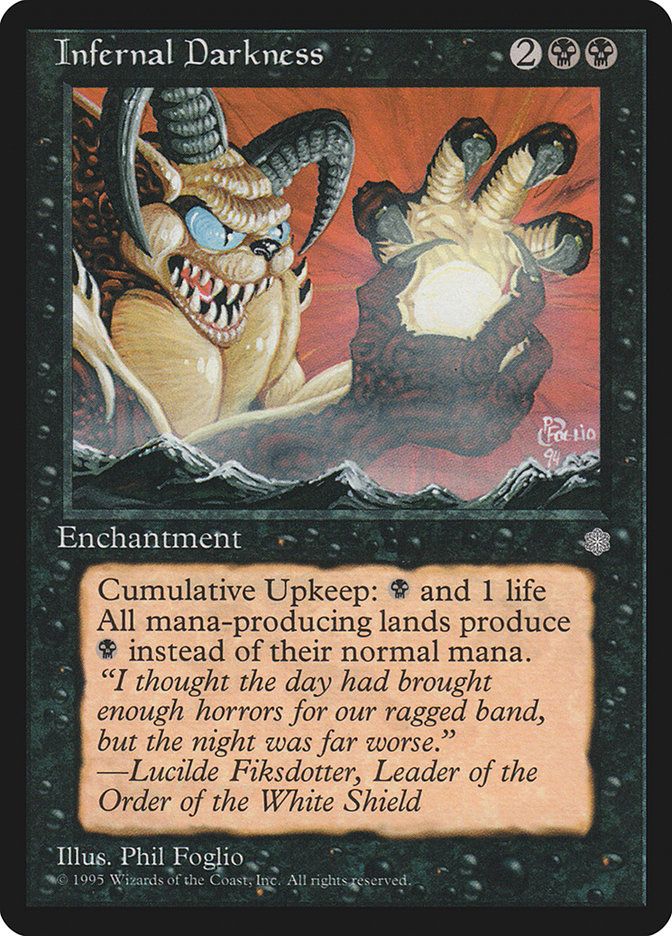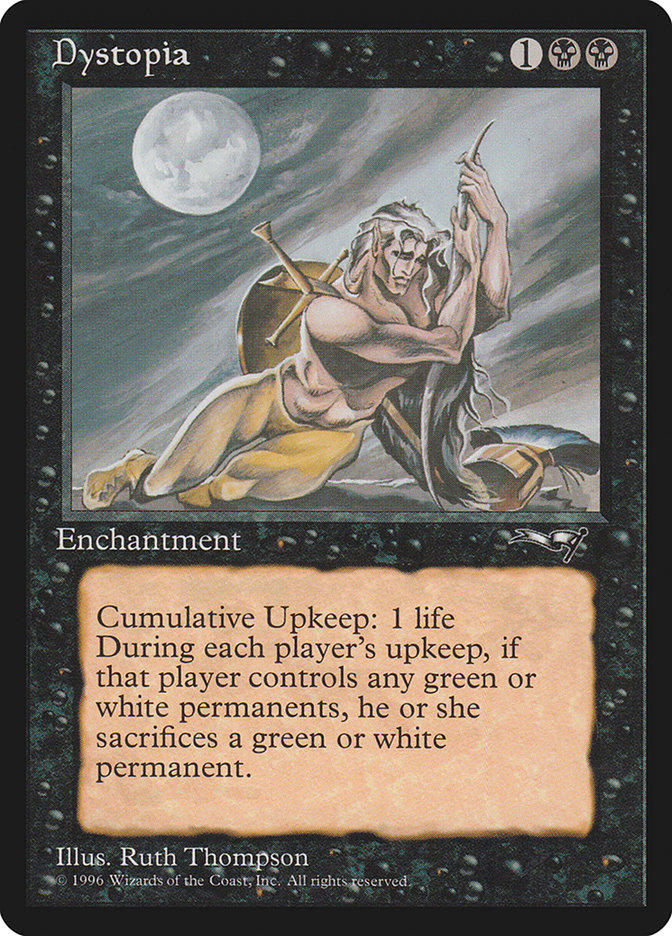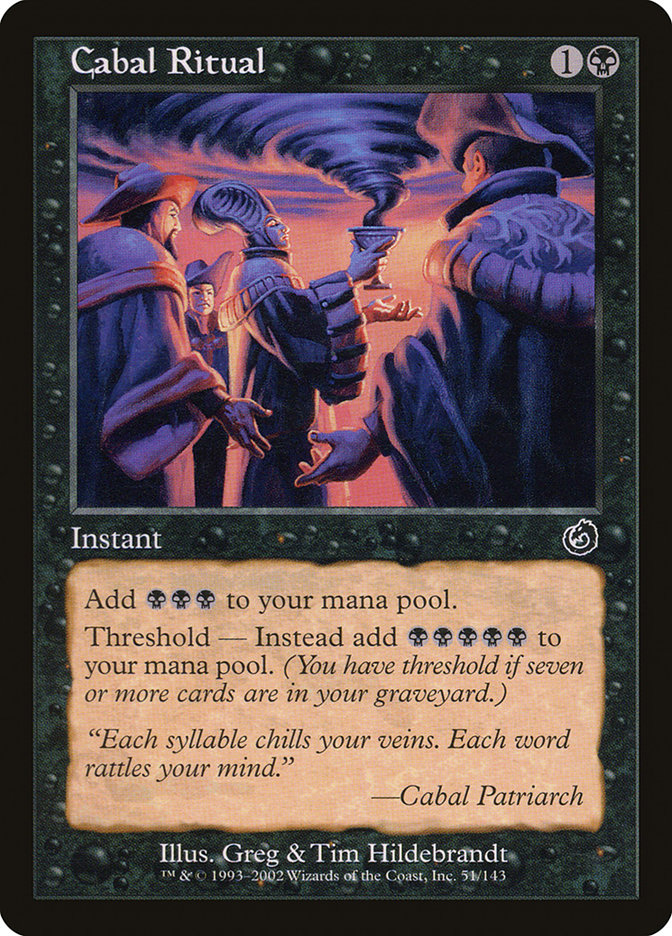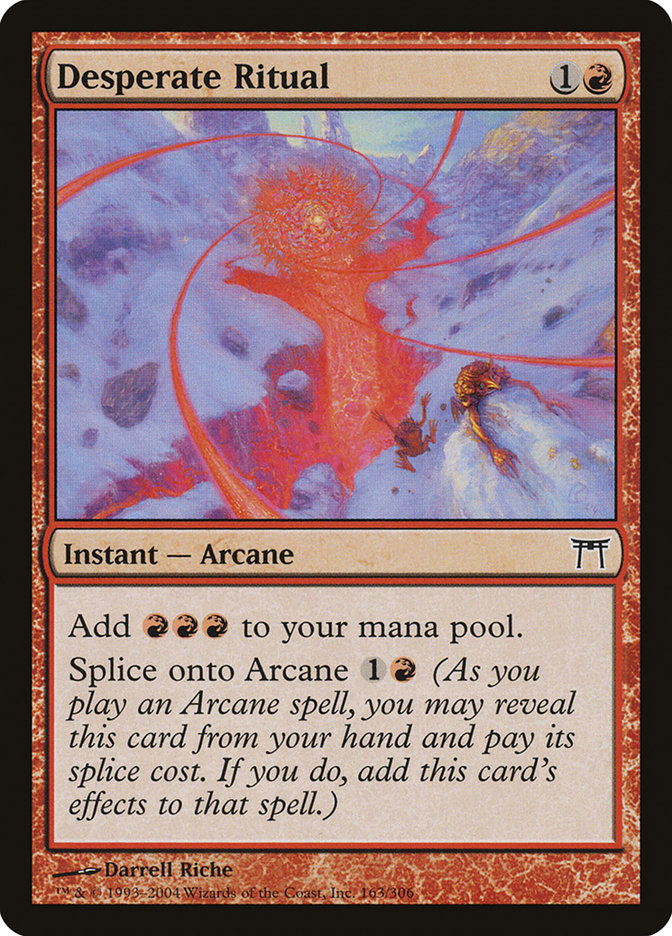Picking out decks for the top ten black cards of all-time was no small
feat. Each of the cards from today and tomorrow’s lists have had so much
success is such a wide array of archetypes, where ought we even begin?
For instance, consider #10, Vampiric Tutor:
#10: Vampiric Tutor
Vampiric Tutor was extremely hyped upon release, and with good reason.
While the world largely underestimated the strength of Impulse, Vampiric
Tutor definitely ended up living up to the hype.
Of course, what’s to stop someone from playing both?
Lands (25)
Spells (35)
- 4 Natural Balance
- 4 Vampiric Tutor
- 1 Drain Life
- 1 Power Sink
- 4 Prosperity
- 2 Memory Lapse
- 4 Impulse
- 4 Squandered Resources
- 4 Infernal Contract
- 4 Cadaverous Bloom
- 1 Elven Cache
- 1 Three Wishes
- 1 Emerald Charm
Sideboard

While some pundits had claimed that cards like Vampiric Tutor were going to
make combos much easier to assemble, others disagreed and were wrong.
Vampiric Tutor’s unmatched mana efficiency translates well into powered
formats, where it’s easy to imagine decks willing to give up a card in
order to finding the right key card, at the right key moment.
Lands (19)
Spells (41)
- 4 Brainstorm
- 4 Vampiric Tutor
- 3 Mystical Tutor
- 4 Grim Monolith
- 4 Duress
- 4 Mana Severance
- 1 Mindslaver
- 4 Goblin Charbelcher
- 4 Talisman of Dominance
- 3 Tinker
- 2 Rushing River
- 4 Chrome Mox
Sideboard

Who cares if you’re down a card if it means drawing whichever half of the
Mana Severance/Goblin Charbelcher combination you were missing?
Vampiric Tutor hasn’t been the exclusive domain of combo decks, however.
There have been plenty of midrange decks that have taken advantage of it as
a way to find one-of “silver bullets” to turn around difficult matchups.
Creatures (14)
Lands (23)
Spells (23)

Here, Vampiric Tutor is not only greatly increased access to Dust Bowl,
Naturalize, and Chainer’s Edict, but also to Living Wish (game 1), and then
whatever awesome sideboard card you want.

Was Hall of Famer Darwin Kastle really looking to Vampiric Tutor for Living
Wish, just to Living Wish for something else?

Those are some high impact options to choose from, and that’s to say
nothing of finding Living Death, Haunting Echoes, or Planar Void after
sideboarding!
Perhaps one of the smartest “fair” Vampiric Tutor decks is the Mono-Black
Napster deck Jon Finkel piloted to a first place finish at the 2000 US
National Championships.
Creatures (9)
Lands (23)
Spells (28)
- 1 Eradicate
- 4 Vampiric Tutor
- 4 Yawgmoth's Will
- 1 Persecute
- 4 Duress
- 4 Dark Ritual
- 1 Stupor
- 1 Perish
- 2 Unmask
- 1 Engineered Plague
- 4 Vicious Hunger
- 1 Massacre
Sideboard

Napster was a somewhat aggressive mono-black control deck, a brainchild of
Michael Flores, that sought to use its playset of Yawgmoth’s Wills to
generate a game-winning advantage. Not surprisingly, this strategy had lots
of holes in it, but that’s where Vampiric Tutor comes in.


That’s right, Perish, Massacre, and Stromgald Cabal all maindeck!
Napster may have had tons of bad cards in every matchup, but the plan was
to find the one or two that really devastated your opponent and ride those
to victory. Besides, after sideboarding, you’ve got access to plenty of
general purpose utility cards to make sure you can get up to 60 cards that
do something.
Imperial Seal doesn’t get its own spot on the list because it’s just a lame
rip-off of Vampiric Tutor. Having to commit at sorcery speed really is a
big cost, but just calling a spade for a spade, it would probably crack the
top 25 itself, even if we held it up alone (albeit much lower on the list).
Unlike Vampiric Tutor, which has been a part of so many real decks and made
much awesomeness possible, Imperial Seal has basically been exclusively
used by Vintage combo decks looking to Tendrils of Agony people to death,
and being willing to play a worse Vampiric Tutor in order to get a second
copy.
Creatures (4)
Lands (14)
Spells (42)
- 1 Tendrils of Agony
- 1 Brainstorm
- 1 Fastbond
- 1 Vampiric Tutor
- 1 Mystical Tutor
- 1 Yawgmoth's Will
- 1 Duress
- 4 Force of Will
- 1 Demonic Tutor
- 1 Hurkyl's Recall
- 4 Doomsday
- 1 Ancestral Recall
- 1 Imperial Seal
- 4 Gush
- 1 Merchant Scroll
- 1 Black Lotus
- 1 Lotus Petal
- 1 Mox Emerald
- 1 Mox Jet
- 1 Mox Sapphire
- 1 Ponder
- 1 Thoughtseize
- 4 Preordain
- 4 Mental Misstep
- 3 Flusterstorm
Sideboard

If your plan is to Gush right away anyway, the sorcery speed isn’t as big a
drawback, or so the story goes.
#9: Hymn to Tourach
Hymn to Tourach ruined an awful lot of games back in the day, when a turn
two Hymn would hit someone’s only land, making the next few turns kind of a
joke.
As discussed last week, Hymn to Tourach was a key four-of in
the 1995 World Championship winning list
used by Alexander Blumke. Then, when the Pro Tour was created in January of
1996, it continued to shine, this time, alongside Necropotence, thanks to
the restriction of Black Vise.
Most people don’t realize just how tough the junior division was in 1996.
Jon Finkel top 8’ed the first Junior Pro Tour, and that year, Kai Budde,
Zvi Mowshowitz, Brian Kibler, and countless other eventual super stars of
Magic lined the room, battling it out. And just to give you an idea of how
much harder core the juniors were than the seniors, compare Leon Lindback’s
third place Necro-deck from the adult division to that of Graham Tatomer in
the younger division.
Creatures (11)
Lands (23)
Spells (26)

Okay, okay, not bad. Jalum Tome, Dance of the Dead, and Dark Banishing are
kind of loose, but all in all, this was a fine first stab at Necropotence.
However, compare that list with that of Graham Tatomer:
Creatures (11)
Lands (24)
Spells (25)

While Lindback did have four Necropotences to Tatomer’s three, I think I
gotta give the edge to the guy with three Demonic Consultations, instead of
zero.
I’m also not a big fan of playing just two Strip Mines, but I think playing
less than four Mishra’s Factory is also a mistake (I just played four of
each in those days).
Of course, in Graham’s defense, his list did feature a playset of
Icequakes, instead of all that weird stuff from above. This was
particularly great for fighting opposing Mishra’s Factories, as well as
just keeping people from being able to cast Armageddon.
Hymn to Tourach was often referred to as “the best land destruction spell,”
on account of its uncanny ability to rip the lands from your opponents’
hands that they were counting on. This denial plan has not been solely as a
complement to Necro, either. Obviously, the B/W Denial deck Blumke won
Worlds with, linked to above, is one example. Here’s another:
Spells (35)
- 4 Hymn to Tourach
- 2 Yawgmoth's Will
- 4 Duress
- 3 Diabolic Edict
- 3 Cursed Scroll
- 4 Dark Ritual
- 4 The Rack
- 2 Pox
- 2 Demonic Consultation
- 3 Funeral Charm
- 4 Urza's Bauble
Sideboard

Yawgmoth’s Will was such an enjoyable way to build a big edge for
mono-black decks and nearly mono-black decks. I wonder if and when we’ll
see such a thing again?
As for powered formats, Hymn to Tourach has still managed to enjoy a good
deal of success for more than twenty years, despite how much of that time
has been without Necropotence’s help.
Creatures (8)
Planeswalkers (2)
Lands (22)
Spells (28)

It sounds funny, but Hymn to Tourach really is the black Mana Drain. It’s
just a far better disruption spell than you should really have any business
getting for just two mana.
Like Mana Drain, Hymn to Tourach would be unreasonably strong at
three-mana, let alone two.
#8: Griselbrand
That’s right, Dark Confidant didn’t crack the top ten, but there is one
black creature better. Griselbrand is just not a realistic Magic card. It’s
like a Yawgmoth’s Bargain that can attack, block, gain life, and that’s
much, much easier to get onto the battlefield without actually paying its
casting cost.
When most people think of Griselbrand, they usually imagine some powered
format combo deck, like Goryo’s Vengeance…
Creatures (16)
Lands (20)
Spells (24)

Or maybe Sneak Attack or Show and Tell…
It should probably set off alarms when a deck that can cheat anything onto
the battlefield it wants without paying for it chooses to play four of
something despite just three Emrakul, the Aeons Torn.
Creatures (7)
Lands (19)
Spells (34)

The Reanimator strategy used to be a lot more interesting to watch, build,
and face. Which giant powerful behemoth would appear in any given game?
What can you do to overcome it? They all had strengths and weaknesses, but
then Griselbrand came along.
Creatures (8)
Lands (18)
Spells (34)

There’s still some value in the Entomb toolbox, but Griselbrand is just so much better than any other creature you could hope to
reanimate. It’s just too much.
And Vintage?
Not surprisingly, Griselbrand is a force to be reckoned with there, too.
Anywhere he goes, he’s kind of the top dog.
Creatures (3)
Planeswalkers (2)
Lands (15)
Spells (40)
- 1 Brainstorm
- 3 Mana Drain
- 3 Show and Tell
- 1 Vampiric Tutor
- 4 Oath of Druids
- 4 Force of Will
- 1 Sol Ring
- 1 Demonic Tutor
- 1 Time Walk
- 1 Ancestral Recall
- 2 Misdirection
- 1 Black Lotus
- 1 Mox Emerald
- 1 Mox Jet
- 1 Mox Pearl
- 1 Mox Ruby
- 1 Mox Sapphire
- 1 Ponder
- 1 Maelstrom Pulse
- 4 Preordain
- 4 Mental Misstep
- 2 Flusterstorm
Sideboard

Now, you might be thinking,
“Sure, Griselbrand is busted in decks that can cheat him onto the
battlefield. Big deal. If he’s so good, why doesn’t anyone ever cast
him?”
Look, eight mana is a lot, but people really do “just cast him.” For
instance, one of the coolest decks of 2013 was the nearly Mono-Black
Control deck Conley Woods built and piloted to a top 16 finish of Pro Tour Gatecrash.
Creatures (16)
Planeswalkers (3)
Lands (25)
Spells (16)

Oh, hell yes!
Conley Woods is a national treasure.
This was not a format setup to support mono-black. You had to mean it.
You gotta admit, just thinking about Crypt Ghast into Griselbrand is
ridiculously fun…
#7: Nether Void
…unlike Nether Void.
My god. What kind of maniacs designed this card?
That said, I guess I do sort of owe my first set of Moxes to the card. When
I was a kid, I didn’t have any money and I didn’t have any Moxes, so I did
the only thing I could do…
What?! No, we stopped playing for ante pretty early on. I meant playing in
tournaments and winning a playset of the Power 9, one piece at a time.

How did I get my start?
Creatures (3)
Lands (25)
Spells (32)

My deck got a lot better, as I won more and more power… It sounds cliche,
but those were the days.
What about these type of people? Do they ever Nether Void?
You bet they do.
Creatures (6)
Lands (19)
Spells (35)
- 1 Vampiric Tutor
- 1 Yawgmoth's Will
- 1 Mana Vault
- 1 Balance
- 1 Sol Ring
- 1 Demonic Tutor
- 1 Ancestral Recall
- 1 Mana Crypt
- 1 Nether Void
- 3 Sphere of Resistance
- 2 Seal of Cleansing
- 3 Crucible of Worlds
- 1 Trinisphere
- 4 Smokestack
- 1 Tinker
- 1 Crop Rotation
- 1 Black Lotus
- 1 Mox Diamond
- 1 Mox Emerald
- 1 Mox Jet
- 1 Mox Pearl
- 1 Mox Ruby
- 1 Mox Sapphire
- 3 Chalice of the Void
- 1 Engineered Explosives

Despite not being castable with the most broken land in the game, Nether
Void is such a stupidly powerful one-card lock, it still shows up from time
to time. Talk about grinding a game to a halt! Armageddon may set the game
back quite a bit, but Nether Void was kind of an Armageddon, from now on.
#6: Dark Ritual
Dark Ritual is a true classic. From the very beginning, it has been a
staple every time its been legal. Nowadays, we don’t think anything of just
how many Rituals have been banned in Modern for producing one mana more
than they cost. It’s hard to believe just how many years, Magic was
dominated by decks featuring four copies of a card that put people ahead by two turns.
Creatures (8)
Lands (24)
Spells (28)
- 4 Necropotence
- 4 Dark Ritual
- 4 Soul Burn
- 4 Contagion
- 3 Infernal Darkness
- 4 Icequake
- 4 Demonic Consultation
- 1 Zuran Orb
Sideboard

One of my favorite Necropotence decks of all-time, Eric D. Taylor’s
Infernalator made great use of Dark Ritual by using it to Icequake people’s
first turn Thawing Glaciers!
Infernal Darkness was the real key to the strategy. While many people were
mucking around with cards like Legions of Lim-Dul and Lim-Dul’s Cohorts,
Eric just wanted to lock people out and then use Lake of the Dead to fuel
big Soul Burns.
Just want to take a moment to call out one of the most busted sideboard
color hosers of all-time, Dystopia.
Now this is how you hate out two entire colors at the same time.
Of course, Dark Ritual has also not just been a tool of Necro decks,
either. Like just about all good black cards, it has been abused in
Tendrils of Agony decks, ad nauseam.
Lands (15)
Spells (45)

While Tendrils of Agony definitely deserves an honorable mention, there’s
no question Cabal Ritual does too.
Even if it didn’t have the threshold bonus, this card would be a major
player. With it? Well, let’s just say, this is a lot better bonus
that you get from Desperate Ritual.
Dark Ritual and Cabal Ritual are so good at producing mana, they have even
been a part of some crazy combo decks that skip playing lands altogether.
Creatures (27)
Spells (33)
- 4 Cabal Ritual
- 1 Grim Monolith
- 4 Dark Ritual
- 3 Cabal Therapy
- 4 Lotus Petal
- 4 Chrome Mox
- 1 Dread Return
- 1 Bridge from Below
- 4 Pact of Negation
- 4 Summoner's Pact
- 3 Manamorphose
Sideboard

That’s right, Dredge isn’t the only way to play without lands in Magic, and
this list is pretty darn good at killing turn 1, with either a Balustrade
Spy or an Undercity Informer letting you flip your whole deck on turn 1.
And if you think that’s crazy, what about the top five…?


